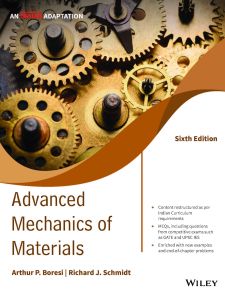Advanced Mechanics of Materials, 6ed, An Indian Adaptaion
ISBN: 9788194726395
584 pages
Publication Year: 2020
For more information write to us at: acadmktg@wiley.com

Description
Advanced Mechanics of Materials is a well-established and comprehensive textbook written for the undergraduate and graduate students of aerospace, civil, and mechanical engineering and applied mechanics. The book presents a unified approach to the study of the behavior of structural members and the development of design and failure criteria. It explores analytical methods for determining the strength, stiffness (deformation characteristics), and stability of the various members in a structural system.
Chapter 1: Introduction
1.1 Review of Elementary Mechanics of Materials
1.2 Methods of Analysis
1.3 Stress–Strain Relations
1.4 Failure and Limits on Design
Chapter 2: Theories of Stress and Strain
2.1 Definition of Stress at a Point
2.2 Stress Notation
2.3 Symmetry of the Stress Array and Stress on an Arbitrarily Oriented Plane
2.4 Transformation of Stress, Principal Stresses, and Other Properties
2.5 Differential Equations of Motion of a Deformable Body
2.6 Deformation of a Deformable Body
2.7 Strain Theory, Transformation of Strain, and Principal Strains
2.8 Small-Displacement Theory
2.9 Strain Measurement and Strain Rosettes
Chapter 3: Linear Stress–Strain–Temperature Relations
3.1 First Law of Thermodynamics, Internal-Energy Density, and Complementary Internal-Energy Density
3.2 Hooke’s Law: Isotropic Elasticity
3.3 Hooke’s Law: Anisotropic Elasticity
3.4 Equations of Thermo elasticity for Isotropic Materials
3.5 Hooke’s Law: Orthotropic Materials
Chapter 4: Applications of Energy Methods
4.1 Principle of Stationary Potential Energy
4.2 Castigliano’s Theorem on Deflections
4.3 Castigliano’s Theorem on Deflections for Linear Load–Deflection Relations
4.4 Deflections of Statically Determinate Structures
4.5 Statically Indeterminate Structures
Chapter 5: Torsion
5.1 Torsion of a Prismatic Bar of Circular Cross Section
5.2 Saint-Venant’s Semiinverse Method
5.3 Linear Elastic Solution
5.4 The Prandtl Elastic-Membrane (Soap-Film) Analogy
5.5 Narrow Rectangular Cross Section
5.6 Torsion of Rectangular Cross Section Members
5.7 Hollow Thin-Wall Torsion Members and Multiply Connected Cross Sections
5.8 Thin-Wall Torsion Members with Restrained Ends
5.9 Fully Plastic Torsion: General Cross Sections
Chapter 6: Bending of Straight Beams
6.1 Fundamentals of Beam Bending
6.2 Bending Stresses in Beams Subjected to Nonsymmetrical Bending
6.3 Deflections of Straight Beams Subjected to Nonsymmetrical Bending
6.4 Effect of Inclined Loads
6.5 Fully Plastic Load for Nonsymmetrical Bending
Chapter 7: Shear Center for Thin-Wall Beam Cross Sections
7.1 Approximations for Shear in Thin-Wall Beam Cross Sections
7.2 Shear Flow in Thin-Wall Beam Cross Sections
7.3 Shear Center for a Channel Section
7.4 Shear Center of Composite Beams Formed from Stringers and Thin Webs
7.5 Shear Center of Box Beams
Chapter 8: Curved Beams
8.1 Introduction
8.2 Circumferential Stresses in a Curved Beam
8.3 Radial Stresses in Curved Beams
8.4 Correction of Circumferential Stresses in Curved Beams Having I, T, or Similar Cross Sections
8.5 Deflections of Curved Beams
8.6 Statically Indeterminate Curved Beams: Closed Ring Subjected to a Concentrated Load
8.7 Fully Plastic Loads for Curved Beams
Chapter 9: Beams on Elastic Foundations
9.1 General Theory
9.2 Infinite Beam Subjected to a Concentrated Load: Boundary Conditions
9.3 Infinite Beam Subjected to a Distributed Load Segment
9.4 Semi-infinite Beam Subjected to Loads at Its End
9.5 Semi-infinite Beam with Concentrated Load Near Its End
9.6 Short Beams
9.7 Thin-Wall Circular Cylinders
Chapter 10: The Thick-Wall Cylinder
10.1 Basic Relations
10.2 Stress Components at Sections Far from Ends for a Cylinder with Closed Ends
10.3 Stress Components and Radial Displacement for Constant Temperature Cylinder
10.4 Criteria of Failure
10.5 Fully Plastic Pressure and Autofrettage
Chapter 11: Elastic and Inelastic Stability of Columns
11.1 Introduction to the Concept of Column Buckling
11.2 Deflection Response of Columns to Compressive Loads
11.3 The Euler Formula for Columns with Pinned Ends
11.4 Euler Buckling of Columns with Linearly Elastic End Constraints
11.5 Local Buckling of Columns
Chapter 12: Flat Plates
12.1 Introduction
12.2 Stress Resultants in a Flat Plate
12.3 Kinematics: Strain–Displacement Relations for Plates
12.4 Equilibrium Equations for Small-Displacement Theory of Flat Plates
12.5 Stress–Strain–Temperature Relations for Isotropic Elastic Plates
12.6 Strain Energy of a Plate
12.7 Boundary Conditions for Plates
12.8 Solution of Rectangular Plate Problems
12.9 Solution of Circular Plate Problems
Chapter 13: Stress Concentrations
13.1 Nature of a Stress Concentration Problem and the Stress Concentration Factor
13.2 Stress Concentration Factors: Theory of Elasticity
13.3 Stress Concentration Factors: Combined Loads
13.4 Stress Concentration Factors: Experimental Techniques
13.5 Effective Stress Concentration Factors
13.6 Effective Stress Concentration Factors: Inelastic Strains
Chapter 14: Contact Stresses
14.1 Introduction
14.2 The Problem of Determining Contact Stresses
14.3 Geometry of the Contact Surface
14.4 Notation and Meaning of Terms
14.5 Expressions for Principal Stresses
14.6 Method of Computing Contact Stresses
14.7 Deflection of Bodies in Point Contact
14.8 Stress for Two Bodies in Line Contact: Loads Normal to Contact Area
14.9 Stresses for Two Bodies in Line Contact: Loads Normal and Tangent to Contact Area
Problems
References
Multiple Choice Questions
Appendix A Average Mechanical Properties of Selected Materials
Appendix B Second Moment (Moment of Inertia) of a Plane Area
Appendix C Properties of Steel Cross Sections
Author Index
Subject Index

